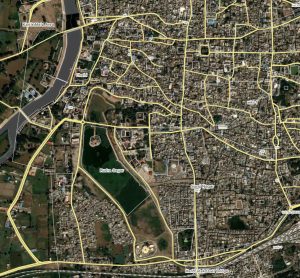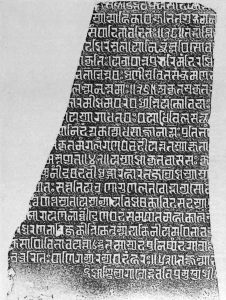Ujjain stone inscription (part a)

Ujjain (District Ujjain, Madhya Pradesh). Satellite view (Wikimapia).

Ujjain (District Ujjain, Madhya Pradesh). Fragment of an inscription (Archaeological Museum, Gwalior).
INIG1304a Kurethā Inscription of VS 1304a
INIG1304a caitra śudi 1 budhavāra Kurethā (Sheopur). Copper-plate inscription. 19 lines, nāgarī, Sanskrit. Mentions the donation of Guḍhhāgrāma in favour of nāyaka Vaccheka or Vaccha by Pratīhāra king Naravarman, younger brother of Malayavarman. Composed by Purutyama (possibly a mistake for Puruṣottama) and engraved by the goldsmith Saḍheka. Now in Archaeological Museum, Gwalior.
INIG1282a Gwalior fort inscription of VS 1282a
INIG1282a āṣāḍha śudi 9 śukravāra Gwalior fort (Gwalior). In the bed of Gaṅgolā tāl. 10 lines, nāgarī, Sanskrit. Records the desilting of the tanks Gogataḍāga and Rājasaras on Gopādri by Talhaṇadevikā, queen of Vigraharāja and mother of the ruler. Further mentions Aruṁdhatī, daughter of Mithilā and wife of king Malayakṣitīśa. The composer was Ānakichūka, son of Yāśodeva and the engraver was ṭha˚ (i.e. ṭhakkur) Vāghadeva. At the end mentions Jivādevī as the queen of the ruler and as the mother of the prince Harivarman and Jayavarman.
INIG1251b Gwalior Inscription of VS 1251b
INIG1251b bhādrapada badi 15 budhavāra Gwalior fort (Gwalior). In the bed of Gaṅgolā tāl. 6 lines, nāgarī, Sanskrit. Records that king Ajayapāla Kacchapaghāta arranged for the desilting of the tank; written by Vīrapāla son of Keśava.
INIG1183 Chait Inscription of VS 1183
INIG1183 māgha śudi 5 Chait (Gwalior). On a pillar in the ruins of a Jaina temple. 6 lines, old nāgarī, Sanskrit. Damaged and not legible.
INIG1161 Gowalior Fort Inscription of VS 1161
INIG1161 māgha śudi 6 Gwalior fort (Gwalior). From a Śiva temple. 9 lines, nāgarī, Sanskrit. Fragmentary inscription mentioning the Kacchapaghāta rulers Bhuvanapāla, Devapāla, his son Padmapāla and Mahīpāla. Records that Manoratha, a Māthura kāyastha, was married to Bhāvā (?) and that he was a servant of Bhuvanapāla. Their son was Mānicandra and he built a temple of Śiva (Smarārāti) and some other gods. Further recounts that Mānicandra was married to Rāsagati and that their sons were Madhusūdana and Āśācandra. The later (i.e. Āśācandra) built the present temple of Hara. Composed by the Jaina sage Yaśodeva. Now in the State Museum, Lucknow.
INIG1150 Gowalior Fort Inscription of VS 1150
INIG1150 Gwalior fort (Gwalior). Two slabs in the porch of the Sās Bahū temple. 22 lines (right side) + 21 lines (left side), old nāgarī, Sanskrit. Describes the construction of and donations to Padmanātha (i.e. Viṣṇu) by the Kacchapaghāta ruler Mahīpāladeva. The main kings of the Kacchapaghāta dynasty are given in the inscription as: Lakṣmaṇa and his son Vajradāman (who defeated the king of Kannauj and conquered Gopādri); Maṅgalarāja; Kīrtirāja and his son Mūladeva (known as Bhuvanapāla and Trailokyamalla) who married Devavṛttā; his son Padmapāla; his heir Sūryapāla and his son Mahīpāla Bhuvanaikamalla who was a brother of Padmapāla. Composed by Maṇikaṇṭa, son of Govinda and the grandson of Rāma; written by Digambara Yaśodeva and inscribed by Padma Siṁhavāja and Māhula, sons of Devasvāmin.
INIG1098 Bara Inscription of VS 1098
INIG1098 Bārā (Shivpuri). Fragment of a large slab inscription. 8 lines, nāgarī, Sanskrit. Records the construction
of a temple of Viṣṇu (Garuḍāsana), a list of merchants involved in the work, and the name of the sūtradhāra Sthirārkka and poet Nārāyana. Now in Archaeological Museum, Gwalior.
INIG1082 Tongra Inscription of VS 1082
INIG1082 [bhadrapada ?] badi 5 Tongrā (Shivpuri).On an image of Nṛsiṃha. 17 lines, old nāgarī, Sanskrit. Describes the construction of a Viṣṇu temple; damaged. Now in the Archaeological Museum, Gwalior.
INIG962 Terāhī Inscription of VS 962
INIG962 vaiśākha śudi 14 guruvāra Terāhī (Shivpuri). On a memorial pillar. 6 lines, nāgarī, Sanskrit. Mentions Allabhaṭṭa (?) and Allajiyapa, who died fighting the Karṇāṭas (i.e. Rāṣṭrakūṭas). Allajiyapa’s wife Nānnā (daughter of Rāūsiddha) committed satī. Now in the Archaeological Museum, Gwalior.